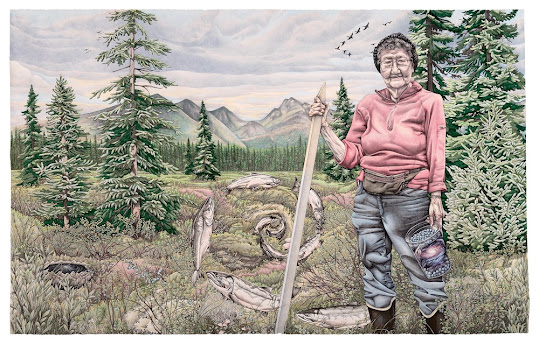This blog is about climate change, rivers, salmon and steelhead fishing, Pacific Northwest people, and ecopoetry.
Wednesday, February 24, 2021
Sir David Attenborough's Warning to Humanity at UN Security Council Feb. 23, 2021
Friday, February 19, 2021
It May Be Too Late for Paris Climate Conference Goal of 1.5 C Meaning "a further 70–90%" of Earth's Coral Reefs May Be Lost According to IPCC
Dave Borlace, noted as best "explainer" in my "Updated Best Practices for Climate Crisis," posted a helpful video on 1/27/21 Is it too late to avoid 1.5 degrees Celsius of warming?. His video notes on 1/8/21 "the European Copernicus Climate Change Service (C3S) published a climate update [ . . . . ]." Borlace says we may reach 1.5 C above the year 1850 baseline "as early as the 2030s, and almost certainly no later than the 2050s." This fits the IPCC (Intergovernmental Panel on Climate Change) post Why are we talking about 1.5°C? noting "If the current warming rate continues, the world would reach human-induced global warming of 1.5°C around 2040."
In my post Two Charts Showing What 2 C, 3 C, 4 C, and 5 C Mean [ . . . . ], I wrote the "IPCC report noted 'Coral reefs, for example, are projected to decline by a further 70–90% at 1.5°C (high confidence) with larger losses (>99%) at 2°C (very high confidence).' I have seen pushback claiming humanity is not in a climate crisis, but tell that to the estimated 500 million to 1 billion people depending on those coral reefs for food and/or jobs that will clearly be lost unless some miracle science, not yet invented, saves them."
Police officers and dancers in "Updated Best Practices for Climate Crisis" received increased Web traffic on my site which they deserve.
Monday, February 15, 2021
Why We Won't Just Leave -- What Alaska Is Telling the World About Climate Change, Virtual Opening and Curatorial Talk by Lindsay Carron on February 27th at 4:00 PM PST Presented on Zoom by Social and Public Art Resource Center (SPARC) in Los Angeles
 |
Tundra Woman (Yup’ik Eskimo Elder Sophie Sakar Berry Picking on Alaskan Tundra) Ink and Colored Pencil on Paper, 4.5 x 7 feet 2019 |
 |
North 1.3: The Gateway Ink and Colored Pencil on Vintage 1952 Alaska Topographic Map 23 x 30in |
 |
Raven Ink and Gouache on Paper, 12 x 12″ 2017 |
 |
North 3.1: Medicine Ink and Colored Pencil on Vintage 1951 Alaska Topographic Map 23 x 30in |
 |
| “The Arctic Miracle of Life” 2017 Arctic National Wildlife Refuge Featuring Betty Brower and Isaac Akootchook of Kaktovik |
Sunday, February 7, 2021
Representative Mike Simpson's (R-Idaho) Plan to Remove Four Lower Snake River Dams
As I wrote in my post below, "Next, I hope we can help orcas and salmon by legally removing the lower four Snake River dams."
Regarding the salmon issue, I'm grateful to fisher/writer Henry Hughes, Alaskan fiddling poet Ken Waldman, and Oregon poet Florence Sage for endorsing my forthcoming book Between River and Street (MoonPath, 2021). I was outfished by Hughes in 2016, and greatly enjoyed his recent Harvard Review fishing story "Rocky and Rose." After reading it, I wrote him the story reminded me of my "social awkwardness due to my obsession with reading water and chasing fish—even when fishing partners, men and women, were troubled, ill, or had enough fishing for the day as I was just getting started with many holes, runs, undercut banks, etc to explore before dark. I’m grateful my wife, Suz, who was raised fishing the Molalla and Clackamas Rivers, fishes with me, and tolerates my fishing obsession. I may have told you about my friend Slim Bracken’s fishing bud who was late to his own wedding because fishing was good that morning. 'Don’t make Suz a fish widow' Slim warned me, explaining his friend was soon divorced after his wedding because he made his bride 'a fish widow.'"
